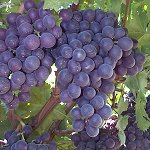


|
HOME EARLY SUMMER · Apples · Apricots · Apriums · Artichokes · Cherries · Figs · Grapes · Nectarines · Peaches · Plums · Pluots MID SUMMER · Apples · Artichokes · Asian Pears · European Prune-plums · Figs · Grapes · Mangos · Nectarines · Peaches · Pears · Plums FALL · Apples · Asian Pears · Grapes · Kiwi Fruit · Oranges · Pears · Persimmons · Pineapple · Plums · Pomegranates WINTER · Apples · Asian Pears · Avocados · Grapes · Grapefruit · Kiwi · Kumquats · Oranges · Pears · Strawberries · Tangerines COMPANY CONTACTS |
Grape Fruit Facts and Information | |
|
Locate a Gift Catalog with Grapes Availability by Variety Recipe Search & More Information | |
 GRAPES,
an edible fruit in the buckthorn family, and of the vines that produce the fruit. The European grape has been used as food since prehistoric times. Grape seeds have been found in remains of lake dwellings of the Bronze Age in Switzerland and Italy and in tombs of ancient Egypt. GRAPES,
an edible fruit in the buckthorn family, and of the vines that produce the fruit. The European grape has been used as food since prehistoric times. Grape seeds have been found in remains of lake dwellings of the Bronze Age in Switzerland and Italy and in tombs of ancient Egypt. The European grape is now commercially cultivated in warmer regions all over the world, particularly in western Europe, the Balkans, California, Australia, South Africa, and parts of South America. Grape varieties, are classified according to their ultimate use. Table grapes must be low in both acidity and sugar content and must conform to definite standards of size, color, and shape. Raisin grapes are preferably seedless, with high sugar content and low acidity. Grapes used to make table wine must have relatively high acidity and moderate sugar content; those used for dessert wines and other sweet wines must have high sugar content and moderate acidity. How to Store: Eat grapes right away or store grapes unwashed in a clear plastic bag separate from other fruit and vegetables in the crisper bin of your refrigerator. Wash with cool water and drain before serving. Grapes can be stored for up to one week. Nutritional Facts: • Fat-free • Saturated fat-free • Sodium-free • Cholesterol-free Detailed nutritional informatin can be found by searching the USDA Nutritional Database. Enter "Grape" (no quotes) as the keyword and select the link and report of interest. Scientific classification: Grapes belong to the family Vitaceae. The European grape is classified as Vitis vinifera, the northern fox grape as Vitis labrusca, the summer grape as Vitis aestivalis, the riverbank grape as Vitis riparia, and the muscadine grape as Vitis rotundifolia. |